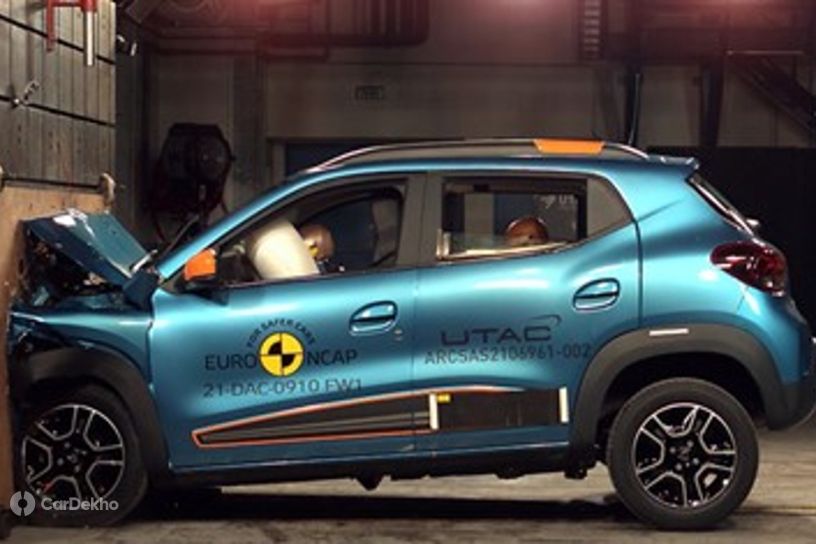Dacia Spring (Renault Kwid EV) Scores Just 1 Star In Euro NCAP Crash Test
Modified On Dec 09, 2021 10:19 AM By Rohit
- Write a comment
Even with additional safety features over the India-spec Kwid, the Dacia Spring offers inadequate passenger protection

The Dacia Spring, the EV version of the Renault Kwid sold in India, has scored a dismal 1 star in the Euro NCAP crash tests. The tested model was a left-hand drive car and had additional safety features such as side head and chest airbags and some Autonomous Driver Assistance Systems (ADAS) tech. It was tested for passenger safety in frontal and lateral crashes, and scored on pedestrian safety as well.
Here’s a detailed breakdown of the Dacia Spring’s crash test result:
Adult Safety
The Spring secured 18.9 out of 38 points in the adult safety category. In the frontal offset test, the passenger compartment remained stable but the risk to the legs of all passengers was termed as ‘high.' Protection to the driver’s chest was also rated as ‘poor.’

Moreover, in the case of the full-width barrier test, the protection to the head of the rear passenger was labeled ‘poor’ while chest protection of both occupants was rated as ‘marginal.’ In both the side barrier and side pole impact tests, protection to the chest was ‘marginal’ but to other critical parts of the body, it was ‘good’. As far as the rear-end collision is concerned, the front seats and head restraints showed good levels of protection from whiplash injuries.
Child Safety

Dacia’s entry-level EV achieved 27.5 out of 49 points in child safety. For the child safety tests, Euro NCAP used dummies based on 6- and 10-year old children. In the frontal offset test, protection of the head and neck of the 6-year old child was rated as ‘weak’, whereas the neck of the 10-year dummy was ‘marginally protected’. In the side barrier impact, all critical body regions were ‘well protected’. The front passenger airbag can be switched off to allow a rearward-facing child restraint to be used in that seating position. ISOFIX seat mounts are only available in the second row facing forward and the Spring doesn’t offer an integrated child restraint system (CRS) at all which affects its overall score.
Also Read: What Does Your Car’s NCAP Safety Rating Really Mean?
Pedestrian Safety
The protection provided by the bonnet to the head of a pedestrian was ‘good or adequate’, with poor results recorded on the A-pillars. The bumper offered ‘good or adequate’ protection to a pedestrian's legs at all test positions. The autonomous emergency braking (AEB) system reacts only to other vehicles and does not detect vulnerable road users such as pedestrians and cyclists. In the end, the Dacia Spring scored 21.3 out of 54 points.
Safety System
Dacia’s Spring comes with assistance systems for speed limiting and autonomous emergency braking (AEB) which is absent on the India-spec Renault Kwid. The AEB showed marginal performance in the conducted tests, lowering its score in this assessment. As per Euro NCAP’s high expectations, the Spring also lacks lane assistance and a driver fatigue detection system.

If the India-spec Kwid is considered, its safety kit includes dual front airbags, ABS with EBD, and rear parking sensors. It doesn’t get ISOFIX child seat anchorages and even misses out on the side airbags compared to its Euro-spec EV-counterpart. Even with the less stringent Global NCAP parameters, the Kwid was only good enough for a two-star rating.
Read More on : KWID AMT
3 out of 3 found this helpful















